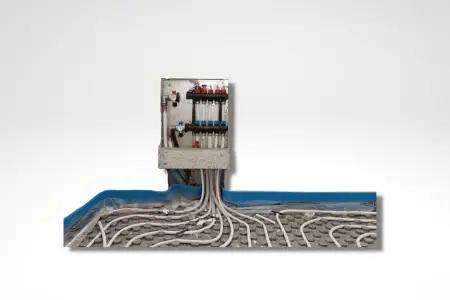Staying cozy indoors despite the freezing cold outside is one of the benefits of radiant floor heating systems. But are you curious about just how long really radiant floor systems last?
An average radiant floor heating system has a lifespan of 50 years.
However, the life expectancy of radiant heating systems varies depending on the kind of components used in the design. For example, regular boilers can last up to 20 years, while tankless boilers have a much longer lifespan.
Your system’s lifespan is also heavily dependent on how well you maintain the system over time.
In this article, we explain everything you need to know about the lifespan of radiant floor heating systems, including what you can do to ensure you get the most our of your investment.
What Affects the Lifespan of Radiant Floor Heating?
Bad care can rip off a good chunk of your systems potential lifespan. It is your responsibility to organize routine checks with a HVAC professional to ensure that the components of your system are in good condition.
Failure to do this will accelerate the wear of the entire system.
Radiant Floor Heating Maintenance Tips
Although, radiant floor heating systems require zero to no maintenance to operate at full life expectancy, a little bit of care on your part can prolong the life span for even longer.
Checking on the pressure of the system as well as the fluid flow rates to ensure that they are at recommended levels keeps your system running in healthy conditions.
The most common issue of radiant floor heating systems is leakage due to freezing in the pipes.
This happens when the heaters are left idle for a long time, causing the water in the pipes to freeze. Freezing can be prevented by running the system on low heat, whenever you’re away from home for a long time.
How to Flush the System
It is essential that radiant heating floor systems are flushed periodically to prevent black smudges, clear the pipe-ways to maintain efficiency & protect against mineral oil contamination.
To flush the system, add a cleaning agent to the flowing water and let it circulate while heated for about an hour. Cleaning time can be prolonged in the case of stubborn iron oxides and lime scale.
How Often to Service the Parts
A couple of routine checks should be performed on a radiant heating systems components annually. Keep the following points in mind:
- A technician should be called once a year to check the pressure of the system. Low pressure may indicate that a leak is present somewhere in the pipes.
- Listen in for any noises in the pump. A properly functioning pump operates quietly; therefore, any notice of strange sounds should be reported to your technician as soon as possible. Having your technician Inspect the values that controls the flow rate through the pipes.
- Ensure that your technician inspects for pipe leaks. The onset of leaks can be diagnosed by observable drops in the heating efficiency of the system.
Annually inspecting your radiant heater system parts is critical to repair minor faults before they lead to the entire collapse of the system.
Which Flooring Works Best for Radiant Heating?
Radiant floor heating is compatible with virtually every existing floor covering. However, choosing floor finishes made up of materials with high thermal conductivity boosts the response time of radiant floor systems.
Stone, ceramic tiles or engineering wood have physical properties that enables them to quickly conduct heat transferred from the pipes network to the floors surface. Besides being good heat conductors, stones & tiles retain stored heat well, making them perfect for regions with high heat loss e.g. conservatories.
Tiles are invulnerable to cracks due to expansion while heated and contraction on cooling because they have a low thermal expansion coefficient.
Laminate flooring is also not susceptible to floor thermal contraction or expansion.
Think twice before choosing carpet flooring- they cause a lot of design limitations to the heating efficiency of your heaters. They are thermal insulators, meaning they take longer time to heat spaces and lose heat energy too quickly.
Contact your contractor before making any adjustments to the flooring finishing in your homes to avoid limiting your systems performance.
Check out this article to learn more about the best insulation for radiant floor heating.
What is the Best Liquid for Radiant Floor Heating?
Tap water supply is the most viable heating fluid choice because of its easily accessibility, however, it is essential that additives are applied to resist the adverse effects of water on the pipes and other components of the system.
Propylene glycol is a solution that prevents freezing in the pipes when added to the water, corrosive effects of water on the boiler is also eliminated by treating the water with a rust inhibition chemical. But note that propylene glycol solutions must be analyzed annually because they may breakdown overtime into harmful chemical compounds.
When the heating system is not tight enough the amount of oxygen in the water may raise to dramatic values and cause corrosion.
What is the Best Material to Use for Underfloor Heating?
The most recommended material for underfloor heating is engineering wood.
The stability of engineering woods makes its structure resilient to weakening caused by rapid temperature changes.
Engineering wood is a composite material obtained by putting together a broad range of wooden products, to achieve design specifications. Hence, wood designed specifically for underfloor heating application will yield max efficiency.
FAQ about Radiant Floor Heating
Q. Can radiant floor heating pipes freeze?
Yes, under the subject of very low atmospheric temperatures, the water present in the heating pipes may freeze if not run for an extended period of time. It is recommended that you leave the radiant floor heating system on low-heat if you’ll be away for a long time.
Q. Can you use radiant floor heating if power goes out?
Radiant floor heating systems designed to accommodate auxiliary solar power sources are very much available. Stored charge by the solar panel powers the system in case of such emergencies.
Following a power outage, the warmth of your space can be sustained for some time by using flooring materials that retain heat.
Q. What type of boilers can be used for radiant floor heating?
Radiant floor heating systems support many types of boilers.
This is not limited to but includes; tankless boilers, condensing boilers, combi boilers, etc.
Q. Do I need a thermostat for radiant floor heating?
It is advisable to get a thermostat for your radiant heat system. You will have no problem finding a wifi thermostat for radiant heat that is reliable and easy to use with your system.
Installing your radiant heat thermostat is straightforward, but if you don’ t have experience with electrical systems, it’s advised you hire a professional.
Conclusion
Radiant heat systems are among the most durable heating solutions available in the market. Just make sure you maintain your system properly. With just a little but of effort, the lifespan of your radiant heat system will make your investment well worth it.

I graduated with a degree in Chemical Engineering and have written for a number of nationally recognized publications in the home improvement space. My skills include fluid mechanics and process engineering and I have worked on numerous projects, including in waste water flow rate calculation and heat balance of steam rollers in the paper industry. My goal as a technical writer is to make complicated topics easy to understand for the average person.
